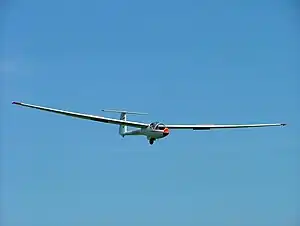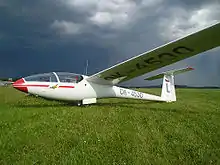Orlican VSO 10
The VSO 10 Vosa (Vosa – Gradient) is a Standard and Club-Class glider designed and manufactured in the Czechoslovak Republic from December 1978 as a replacement for the VT-116 Orlik II.[1]
| VSO 10 Gradient | |
|---|---|
 | |
| VSO 10 Gradient | |
| Role | Club-class sailplane |
| Manufacturer | VSO (Vyvojova Skupina Orlican) |
| First flight | 26 October 1976 |
| Introduction | 1979 |
| Number built | 225 |
Development
Development of the VSO 10 started in 1972 and the first prototype flew on 16 September 1977. The Type Certificate was granted on 15 May 1979, with the first production gliders entering service with Czechoslovak aeroclubs soon after. In 1990 the company ceased production when they started to build Schempp-Hirth gliders. Schempp-Hirth are the current holders of the VSO 10 Type Certificate.[1]
Design
The VSO 10 is a mixed-construction glider with wooden and steel tube structural members, aluminium alloy rear fuselage and glass-fibre sandwich skins. The wings are shoulder-mounted and the tailplane is mounted on top of the integral fin. Conventional control surfaces include all-wooden slotted ailerons, all-metal DFS airbrakes on the upper and lower surfaces of the wing and fabric-covered all-metal elevators and rudder. The undercarriage in the Standard Class aircraft is a manually retractable rubber-sprung monowheel with a drum brake, (non-retractable in the Club-Class aircraft), with a rubber-mounted steel skid under the tail. The pilot is accommodated in a fully reclined seat under a two-piece canopy. Provision is made for 56 L (15 US gal; 12 imp gal) of water ballast to optimise cross-country performance in strong lift conditions.[1]
Variants
- VSO 10B Vosa (Gradient)
- Retractable landing gear variant
- VSO 10C Vosa Club (Gradient Club)
- Fixed landing gear variant
Specifications (VSO 10)

Data from Jane's All the World's Aircraft 1988–89 [1]
General characteristics
- Crew: one
- Length: 7 m (23 ft 0 in)
- Wingspan: 15 m (49 ft 3 in)
- Height: 1.38 m (4 ft 6 in)
- Wing area: 12 m2 (130 sq ft)
- Airfoil: root:Wortmann FX-61-163 ; tip:Wortmann FX-60-126
- Empty weight: 250 kg (551 lb)
- Max takeoff weight: 380 kg (838 lb)
Performance
- Stall speed: 68 km/h (42 mph, 37 kn)
- Never exceed speed: 250 km/h (160 mph, 130 kn) in smooth air
- 160 km/h (86 kn; 99 mph) in rough air
- 160 km/h (86 kn; 99 mph) on aero-tow
- 120 km/h (65 kn; 75 mph) on winch launch
- g limits: +5.3 -3.5
- Maximum glide ratio: 36 at 90 km/h (49 kn; 56 mph)
- Rate of sink: 0.64 m/s (126 ft/min) at 73 km/h (39 kn; 45 mph)
- Wing loading: 31.67 kg/m2 (6.49 lb/sq ft) max
References
- John W.R. Taylor, ed. (1988). Jane's All the World's Aircraft 1988-89. London: Jane's Information Group. pp. 620–621. ISBN 0-7106-0867-5.
Further reading
- Hardy, Michael (1982). Gliders and Sailplanes of the World. Shepperton: Ian Allan. p. 138.
- Taylor, Michael J. H. (1989). Jane's Encyclopedia of Aviation. London: Studio Editions.